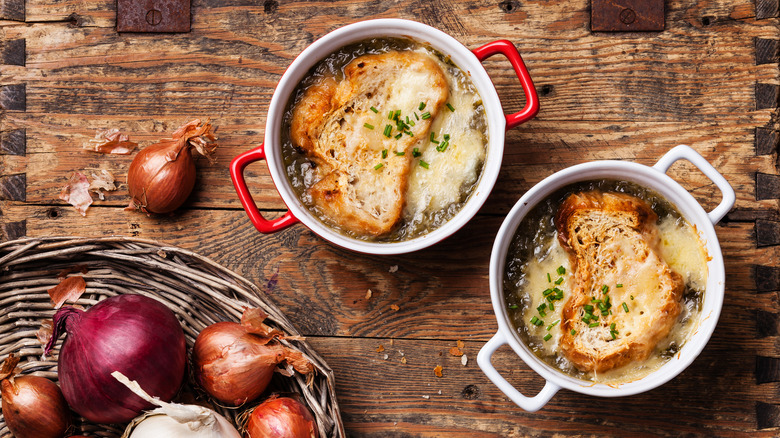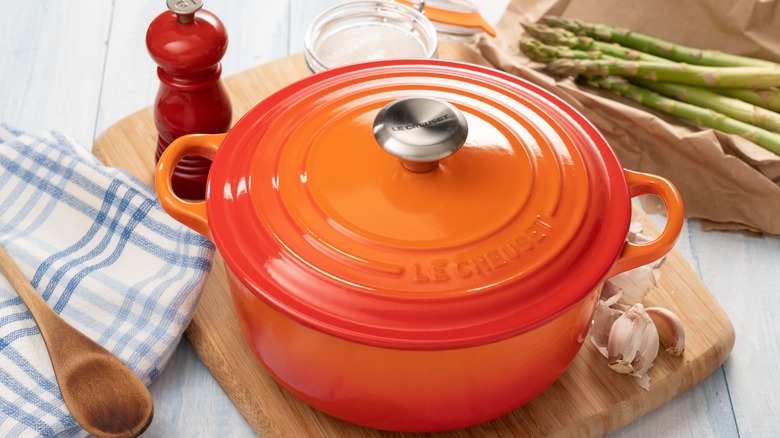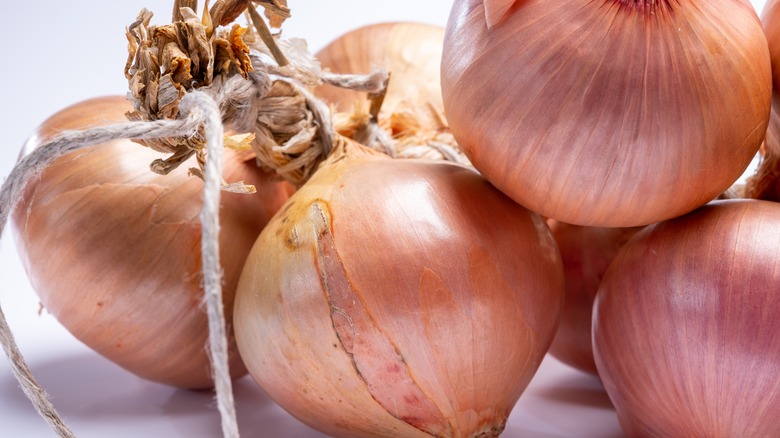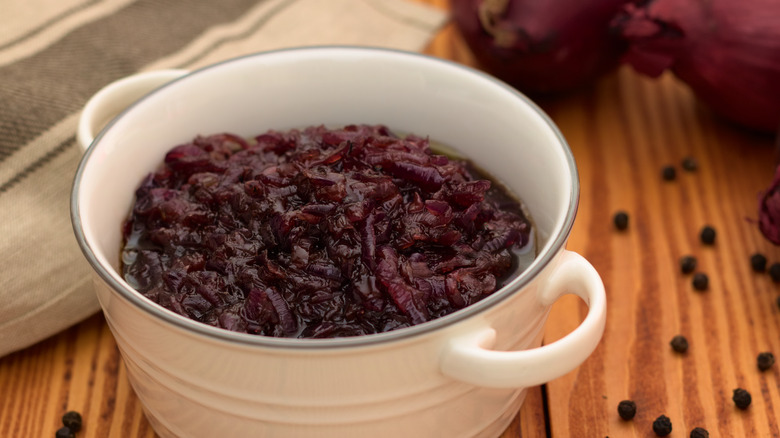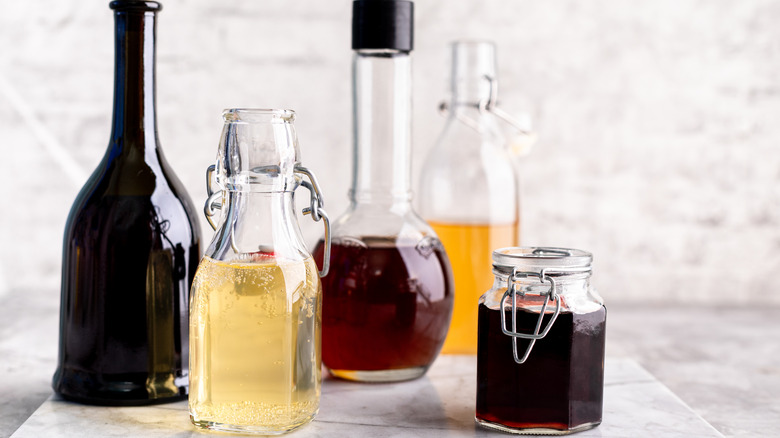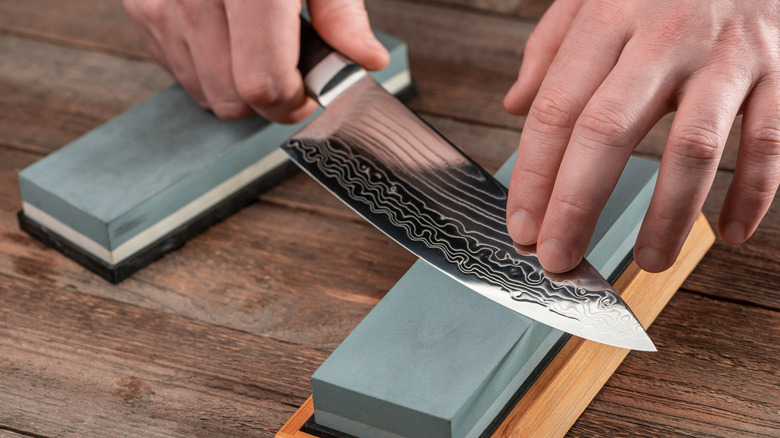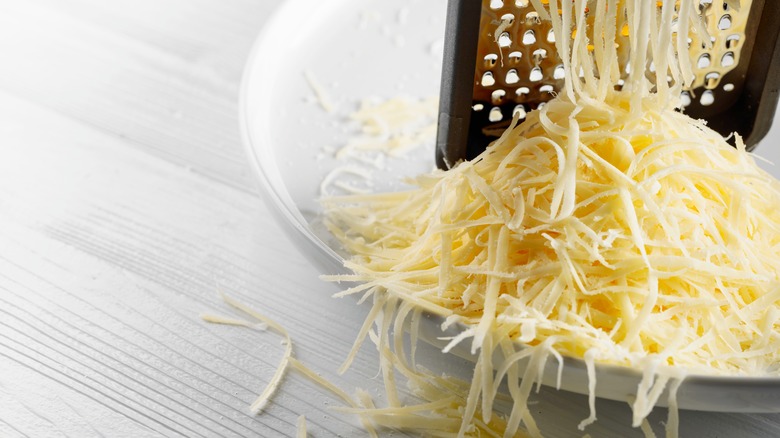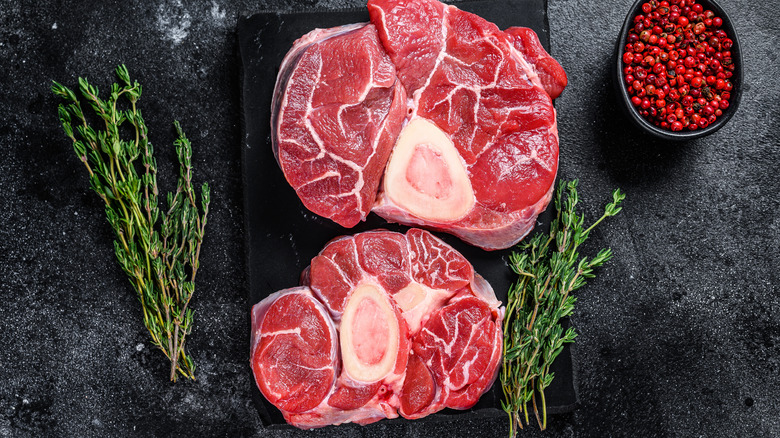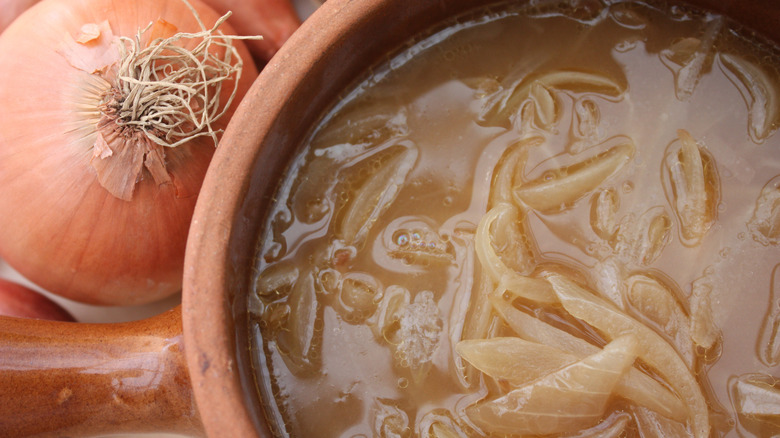12 Chef-Approved Tips For Making The Perfect French Onion Soup
From the bouchons of Lyon to Parisian bourgeois restaurants, we take a trip to discover the secrets behind one of the most prominent dishes of French cuisine — the French onion soup. Sometimes referred to as the ultimate hangover elixir or a French version of pizza (via Vice), this classic dish has a surprising ability to intimidate us. Beyond its seemingly humble appearance lie secrets and techniques that every chef familiar with French cuisine had to master once in their life.
In our humble opinion, a well-made French onion soup recipe is the ultimate savory expression of simple ingredients expertly taken to a whole new level. It's so ridiculously good that we want you to make it more often. So get your knives out, as with all the tips we've gathered from the top chefs in the world, as there will be no more guessing and no more doubting in yourself. Read on for a speed-learning course in French cooking — the next thing you know you'll be standing at the stove browning onions and building stacks of cheese on your soupe à l'oignon gratinée.
1. Cook it in a Dutch oven
To find our first inspiration for a French onion soup, we have to travel to Petite Jacqueline's, a Parisian bistro in Portland, Oregon, where Nicholas Dalaimo, a young, talented chef from southern California, makes his heavenly version of the restaurant's signature course (per Leroux). The French bistro is known for its unpretentious menu and fresh ingredients.
To make the soup, Chef Dalaimo opts for a heavy Dutch oven. As he explains, the choice of pan is very important as it allows you to prepare a restaurant-quality French onion soup from start to finish in a single pot. The heavy-duty pot is perfect for browning onions and simmering them with stock. It can then be transferred straight into the oven to finish the soup off with melted cheese and croutons.
Dutch ovens are designed for slow cooking, making them an ideal pot for a French onion soup. They are durable and have great heat-holding properties, so having one for cold winter months might be just what you need to up your soup-cooking game.
2. Wrap your soup with pastry dough
Australian chef Billy Hannigan brings his experience in Europe to Loulou, a favorite French bistro, boulangerie, and traiteur in Sydney. Among its exclusively-French selection of pastries, artisanal products, and menu items, we find an authentic version of French onion soup inspired by Paul Bocuse's' famous soupe aux truffes. In this dish, the soup is served with a beautiful puff pastry top, a unique twist that adds a fine element to an old classic. Chef Hannigan even serves it in the exact same pedestal soup bowl as a tribute to the late master (via Broadsheet).
He doesn't recommend making the pastry from scratch, however, and instead suggests an easier option — a ready-made frozen pastry. To add this twist to your French onion soup simply cook the soup and put it into an oven-safe bowl. Add a nice layer of Gruyere cheese, top it with a piece of the pastry sheet, brush it with an egg yolk, and pop it in the oven. Fifteen minutes later you'll have an elevated version of the soup that is sure to impress your guests. The best part, according to Hannagan, is that while it may sound like a complicated affair, the French onion soup is an inexpensive treat for a chilly winter evening.
3. Use the right onions
In the mid-19th century, French farm merchants made their way over the English Channel from Roscoff town in Brittany (via The Herald). The British called these men "Onion Johnnies" and always greeted them with excitement, as they appeared every summer, carrying with them bundles of pink Roscoff onions. Onion Johnnies may be a thing of the past, but this delicately-sweet breed of alliums is highly regarded among chefs today.
Raymond Blanc, the chef patron at Le Manoir aux Quat Saisons, England, calls for Roscoff onions whenever he's making a French onion soup. His version of the soup doesn't include meat stock; instead, he focuses on the quality of the onions and their natural sweetness and acidity. For a more robust onion flavor, he suggests browning them until they are dark and deglazing them with dry white wine. Chef Blanc recommends cooking the wine off quickly to remove the bitterness of the alcohol; you're left with the gentle fruitiness of the wine. Finally, he likes to finish the soup with a 2-year-old Comté. If you're lucky to come across Roscoff onions, try this version from the acclaimed French chef.
4. Serve it in the proper bowl
Over the course of six decades, Jacques Pepin, an 87-year-old celebrity TV chef, author, and educator, has become a beloved persona in America for his tireless positivity and genuine passion for cooking. Although Chef Pepin considers himself a "quintessential American chef" (via Forbes), his French heritage surely makes him trustworthy on matters of French cuisine.
In the American Masters: At Home episode "Jacques Pépin Makes Onion Soup Gratinee," he shares his version of a rustic French soup (via PBS). As you'd expect from Chef Pepin, he doesn't do complicated; he strips everything down to a few key ingredients, omitting alcohol and herbs, but points to a very important detail — a serving bowl. Pepin suggests a lug soup bowl with a lip so the cheese sticks to it and prevents it from sinking. As we all know, the crispy parts of the cheese are usually the best bits, so we think he has a point here.
5. Take your time
Sometimes, cooking is about not rushing the process; it's about preparing yourself for the event. And who is better at telling us about the art of slow cooking than Thomas Keller? A decorated American chef and restauranteur at the famous French Laundry in Napa Valley, Chef Keller is well known for his obsession with perfection. To no surprise, in his tribute to the classic French onion soup, he allows for a good part of the day to be devoted to preparing onions for the soup (via The Guardian).
Chef Keller slow-cooks the onions for no less than five hours or until extreme caramelization is achieved, resulting in a candy-like, crispy onion treat. He then pours rich, homemade beef stock over it. In his "Bouchon" cookbook, Keller also gives us a hint that the soup gets even better the next day and suggests to rest it in a fridge overnight before serving. Now we know that time is something we all may be lacking in our lives, but trying Chef Keller's' version of the soup should teach us some patience. After all, isn't happiness found in the moments we savor?
6. Opt for bold flavors
Anthony Bourdain was one incredible chef. His open confessions in the book "Kitchen Confidential: Adventures in the Culinary Underbelly" gave us a bitter glimpse into the ruthless restaurant industry. Despite his obvious revulsion towards it, it was coming from a point of compassion and love for the craft. And oh boy, he knew how to cook. In his famous "Les Halles Cookbook," he shared a generous collection of French bistro recipes and techniques, including his take on a French onion soup.
As you'd expect from a rockstar chef, he goes all in on the flavor. To create the rich and dark body for the soup, he deglazes the onions with balsamic vinegar and port wine, followed by the dark chicken stock. To make it even more intensely flavored, he reaches for bacon, which is simmered in the soup. And if you can't be bothered with clay pots, Chef Bourdain offers a "half-assed" alternative: Cooking the bread covered in cheese on a sheet pan should give similar results to the classic.
7. Master pain-free onion preparation
Making an onion soup involves, well, slicing onions. This is one of the very first skills cooks are taught at culinary school and it all starts with the sharp knife, according to renowned French chef and restauranteur, Alain Ducasse. When asked to demystify the secrets behind the staple French dish, he first points to the step of onion preparation and advises that you cut them with an incredibly sharp knife (via Lucy Lean). He explained, "The fumes that cause your eyes to water are released when the petals [of the onion] are crushed — a common issue when slicing with a dull knife." By using a sharp knife and mastering your cutting technique, the recipe might seem less painful to execute.
Another tip from the French master is to never cook onions on low heat to start with — a few minutes on high heat will ensure your soup has the ideal color and intensity. If you fail to follow this through, you are risking your onions turning all mushy, and we definitely don't want that. Finally, Ducasse likes to add a dash of Cognac to flavor the soup at the end, which gives it a subtle fragrance and spiciness.
8. Use plenty of onions and cook them in oil
Now that we've learned the importance of using a proper knife, we are ready to face the hard-not-to-cry-over truth about the French onion soup — we'll need a lot of onions! Edward Delling Williams, a British chef and the man behind the neo-bistro movement in Paris (via The Good Web Guide), has a few secrets of his own when it comes to mastering the famous French dish.
For Williams, it all starts with the onions. When making the soup in his restaurant, The Presbytère, he uses up to 55 pounds of them for every gallon of soup he makes, per Salon. To put that in perspective, he suggests you need half a pound of onions for each serving. We trust him on this.
When it comes to cooking the onions, he has another secret tip up his sleeve. Williams suggests frying onions in a generous amount of oil — "the one-to-one onion-to-oil ratio," to be exact. According to the chef, it's the ultimate key to getting a lot of flavor from the onions. And if you're worried about the soup being oily, he offers a solution for that also: Refrigerate your finished soup and scoop the fat off the top before reheating it again.
9. Try going really meaty with it
In Montreal, Canada, we find a sibling of a famous Parisian brasserie, Au Pied de Cochon, first opened next to the most influential food market in France at the time, Les Halles. The legendary establishment remained open 24/7 since 1947 and has become a very popular destination in Paris among celebrities, politicians, and travelers (per EU Touring). Au Pied de Cochon now has branches around the world, including a Canadian restaurant in Montreal run by one of the best chefs in Canada, Martin Picard.
Chef Picard stayed true to his roots and created a menu inspired by Canadian-French cuisine. As a nod to tradition, he also serves his own signature version of onion soup at Au Pied de Cochon. Just like most of the menu revolving around meat, the onion soup is no exception. The ingredients he uses are intriguing at least; he swaps the beef stock with pork and adds lardons as well as local red beer (via The New York Times). To add even more flavor to the soup, the soup is used to blanch meats and sausages during the restaurant's service, making Picard's version of French onion soup the meatiest we've seen.
10. Don't be stingy with the cheese
Ludo Lefebvre is a Michelin-trained chef who currently runs a bistro, Petit Trois in Los Angeles, and a restaurant, Chaz Maggy in Denver. He demonstrates his flare for French cooking in the special feature for Food & Wine, where he deconstructs the French onion soup and shares a number of valuable tips to make it absolutely delicious.
Chef Lefebvre is a fun chef to watch, but he takes the task very seriously. He starts his soup by slicing the onions quite thick, which provides a nice texture and crunch. Instead of regular oil, Lefebvre likes to use grapeseed oil due to its high heat tolerance — a smart way to caramelize onions without burning them. Nevertheless, he warns us to stay focused as onions need help from regular stirring.
Another surprising addition is Worcestershire sauce. According to the chef, it compliments the beef flavor well; a few spicy notes can't harm the rich beefy stock. As a final touch to the recipe he recommends being extra generous with the cheese — his version gets plenty of it, enough to drip all over the sides. It's no surprise Chef Lefebvre calls the soup a "liquid sandwich."
11. Create depth with beef shanks
Sometimes we wish our soup tasted more like a full meal, and classic onion soup seems to lack that a bit. Daniel Boulud, a highly-acclaimed French chef and restaurateur, has come to the rescue. In his "Cafe Boulud Cookbook," he shares a truly unique interpretation of the beloved French classic.
To make his soup truly irresistible, he roasts beef shanks and adds them to the simmering stock with onions. As they cook slowly, they release a lot of additional flavor into the soup turning it into a full, hearty dinner. Beef shanks serve a double purpose here; instead of making a traditional au gratin with cheese, you could try his suggestion and serve the bone marrow from the shanks with bread instead of putting the bread on the soup. And to finish it off, he recommends sprinkling it with some quality sea salt. We definitely like the sound of that!
He also mentions a little-known fact about the traditional Lyon etiquette of eating onion soup: As soon as there is only a bit of the soup left, it's usually mixed with the last drop of wine and drunk directly from the bowl.
12. Cook fast -- eat slowly
A question we kept to the end is whether we could make a quick version of a French onion soup. To answer that, we turned for advice to a British-born French chef, Michel Roux Jr. Chef Roux Jr. comes from a family of famous cooks; both his late dad, Albert Roux, and his late uncle Michel Roux Sr., were prominent figures in British gastronomy, and Michel Roux Jr, is no exception to that. Today, he continues to run the family restaurant, Le Gavroche in London, and is a man that knows best how to turn French onion soup into a speedy weeknight dinner.
Even though he refers to his onion soup as "easy going" (via Saveur), it still demands the same level of care and attention. To make the recipe he follows just a few simple steps. He cooks the onions briefly to give them a bit of color adds butter and flour to create a blond roux. He then adds cider, stock and herbs, and finishes it off with a classic cheese au gratin. The result is a bright and fragrant soup with hints of fruity notes from the cider — all done within an hour. After whizzing through the recipe, Chef Roux invites us to slow down as the soup needs time to be savored.
